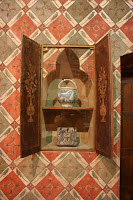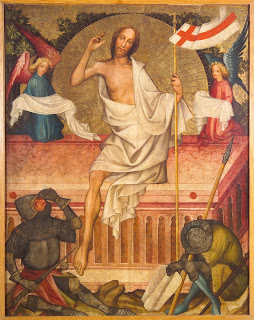Medieval History
 Italy's museums and church treasuries are full of medieval art - this is especially true of Florence, home of the Uffizi, the Bargello, the Museo dell'Opera del Duomo, and many other museums. I would like to mention another institution, which is housed in a medieval/early Renaissance building, and houses a collection largely from the same period, even if the quality and quantity of the objects is not on par with the institutions mentioned above. The Palazzo Davanzati first opened as a museum in 1904, and contains a number of early Renaissance sculptures, paintings and tapestries, as well as an interesting cycle of wall-paintings preserved in various rooms of the house. The collection of everyday utilitarian objects is also of note. Browse some objects on the Italian-language version of the official website, and have a look at the Arttrav blog to read more on the museum.
Italy's museums and church treasuries are full of medieval art - this is especially true of Florence, home of the Uffizi, the Bargello, the Museo dell'Opera del Duomo, and many other museums. I would like to mention another institution, which is housed in a medieval/early Renaissance building, and houses a collection largely from the same period, even if the quality and quantity of the objects is not on par with the institutions mentioned above. The Palazzo Davanzati first opened as a museum in 1904, and contains a number of early Renaissance sculptures, paintings and tapestries, as well as an interesting cycle of wall-paintings preserved in various rooms of the house. The collection of everyday utilitarian objects is also of note. Browse some objects on the Italian-language version of the official website, and have a look at the Arttrav blog to read more on the museum.
Finally, as this is a blog on medieval Hungary, I would like to mention Hungary's most important museum dedicated to ecclesiastical art - and thus containing many medieval and Renaissance objects, especially paintings and altarpieces. This is the Christian Museum in Esztergom, created and opened by Archbishop János Simor in 1875 and located on the second floor of the Primate's Palace. The collection includes a significant ensemble of late medieval Hungarian altarpieces and panel paintings, including the Calvary altarpiece painted by Thomas de Coloswar in 1427. There are also several Austrian and German medieval panels, as well as a significant collection of early Italian panel paintings. The website of the museum provides a good overview of the collections in English (with rather small, but still useful images). I wrote on the medieval holdings of the museums of Budapest in a previous post.
- Medieval Exhibitions In New York
I am currently on vacation in the New York area, and thus I had a chance to explore the museums of New York City a little bit. As always, there are plenty of medieval things on offer here - the following is my recommendation to lovers of medieval art...
- Exhibition Of Medieval Art In Cologne
Last week I had a chance to see the exhibition "Glanz und Grösse des Mittelalters" at the Schnütgen Museum in Cologne (Splendour and Glory of the Middle Ages). The new building of the Rautenstrauch-Joest-Museum provides a spacious and modern exhibition...
- New Medieval Art Websites, Iii.
I will keep this post very short - there seems to be an ever richer selection of medieval art websites out there. I just want to point out a few I've recently discovered. The Utrecht Psalter Medieval manuscripts in Dutch collections "This database...
- Hungarian Goldsmith Objects Enter The Metropolitan Museum
Chalice with filigree enamel Hungary, 1462 Metropolitan Museum of Art One of the most important collection of Hungarian goldsmith works outside Hungary was assembled by financier Nicolas M. Salgó, former US ambassador in Budapest. Salgó collected...
- Medieval Holdings Of Budapest Museums
I often find myself trying to explain the system of Budapest's major art museums to foreigners. Although it is a clear system, it can still be confusing at times. For example, you can find important medieval artworks in all major museums of the capital....
Medieval History
Museums of Medieval Art
My recent visit to the Schnütgen Museum in Cologne got me thinking about museums focusing mainly on medieval art. I decided to make a brief list of such museums, with direct links to their collection databases - thousands of medieval artworks can be discovered this way.
 |
| Reliquary ('Ursulabüste'), Museum Schnütgen, Köln |
Let's start with the Schnütgen Museum, then (Museum Schnütgen, Köln). Located in the Romanesque church of St. Cecilia, this 100 year old museum received a complete makeover, completed last year. The new entrance opens from a large hall, which is in the new building erected for the Rautenstrauch-Joest-Museum, a museum of world cultures. The collection of the Schnütgen Museum consists largely of Christian religious objects, ranging from the Early Christian period to the Baroque, with a strong focus on sculpture, liturgical textiles and stained glass from Cologne and the Rheinland. There is no full collection database online, and the English version of the website only provides basic information. The website however does provide a good overview of chief works on display. An audioguide to the museum is available for download - although I don't know what its purpose is without the artworks.
 |
| Lady with the Unicorn, Musée Cluny, Paris |
Maybe the most famous of all medieval art museums is the Musée Cluny in Paris - officially the Musée national du Moyen Age. Located in the building of the Gallo-Roman thermes and the 15th century Hôtel de Cluny, and surrounded by a medieval garden, visiting this museum is a unique experience. The collection ranges from late Antiquity to the late Middle Ages, and includes exceptional goldsmith works, stone sculptures from Parisian churches - such as the Notre-Dame, as well as the famous Unicorn tapestries. There is a brief overview of the collection on the museum's website, but a lot more objects and images can be found through the photo agency of the Réunion des musées nationaux (where you can search for specific objects, but also by selecting the museum on the search form). The Museum's objects are also incorporated into the French national art database, Joconde. You can select the Musée Cluny directly, or search for thousands of other medieval objects in various French collection. In addition, a fascinating resource on the museum is also available online: the catalogue of 13th century sculptures (Les sculptures du XIIIe siècle du musée de Cluny).
 |
| The Unicorn in Captivity The Cloisters, The Metropolitan Museum |
The only similar museum to the Musée Cluny is on the other side of the Atlantic, in Manhattan: The Cloisters, a branch of the Metropolitan Museum of Art, New York. Housed in a large pseudo-medieval structure, which contains actual chapels and cloisters shipped over from Europe, this is one of the finest collections of medieval art anywhere. The website of the Metropolitan Museum provides a lot of information on The Cloisters, and also on the medieval department, including a selection of works on view. The collection is rich in sculptures of all kind, goldsmith works, manuscripts and also includes another set of Unicorn tapestries. You can search these objects in the museum's Collection Database, which is continually growing. If you select The Cloisters from the list of collections, 2300 objects can be browsed at present (about half of which are on view). Selecting the Collection of Medieval Art from the list yields an incredible further 6700 medieval objects in the database.
You can also download the Metropolitan Museum's Resource for Educators on Medieval Art.
I would like to mention that many other American museums made their collections accessible online. For medieval art, I would particularly recommend the database of the The Walters Art Museum in Baltimore (see also the manuscripts there!) and that of The Cleveland Museum of Art, with 1214 works online.
To continue, I would like to mention a few more museums, which - while collecting many other things - are particularly famous for their medieval collections. Two museums in London - the Victoria and Albert Museum and the British Museum - have recently re-installed their medieval collections. The Medieval and Renaissance Galleries at the V&A reopened in late 2009, and now provide an unprecedented detailed overview of decorative arts and sculpture of medieval Europe. The new website of the museum provides detailed information on the galleries and on the collection, including articles, videos and a blog. The collection database of the museum provides photos and detailed information on thousands of objects. The galleries on Medieval Europe in the British Museum have also been refurbished. A search for the word "medieval" in the collection database yields thousands of results.
| Sant Climent de Taüll |
The Museu Nacional d'Art de Catalunya in Barcelone houses the world's most important collection of Catalan art, and is particularly famous for its medieval collection, especially for its collection of Romanesque mural paintings. The Museum created a new resource (available in English), its online collections, which provide hundreds of images of Romanesque and Gothic objects on view. Some of the objects - such as the apse frescoes of Sant Climent de Taüll - are also available on high-resolution photos.
The Romanesque galleries have just been reopened on June 30 with a new presentation (see also the press release, pdf). A series of photos are also available on flickr.
 |
| Resurrection by Thomas de Coloswar Christian Museum, Esztergom |
Please let me know your favorite medieval art museum, especially if it is not listed above!
- Medieval Exhibitions In New York
I am currently on vacation in the New York area, and thus I had a chance to explore the museums of New York City a little bit. As always, there are plenty of medieval things on offer here - the following is my recommendation to lovers of medieval art...
- Exhibition Of Medieval Art In Cologne
Last week I had a chance to see the exhibition "Glanz und Grösse des Mittelalters" at the Schnütgen Museum in Cologne (Splendour and Glory of the Middle Ages). The new building of the Rautenstrauch-Joest-Museum provides a spacious and modern exhibition...
- New Medieval Art Websites, Iii.
I will keep this post very short - there seems to be an ever richer selection of medieval art websites out there. I just want to point out a few I've recently discovered. The Utrecht Psalter Medieval manuscripts in Dutch collections "This database...
- Hungarian Goldsmith Objects Enter The Metropolitan Museum
Chalice with filigree enamel Hungary, 1462 Metropolitan Museum of Art One of the most important collection of Hungarian goldsmith works outside Hungary was assembled by financier Nicolas M. Salgó, former US ambassador in Budapest. Salgó collected...
- Medieval Holdings Of Budapest Museums
I often find myself trying to explain the system of Budapest's major art museums to foreigners. Although it is a clear system, it can still be confusing at times. For example, you can find important medieval artworks in all major museums of the capital....
